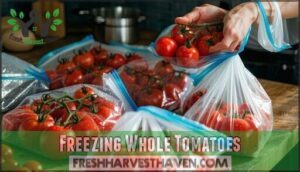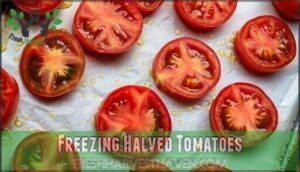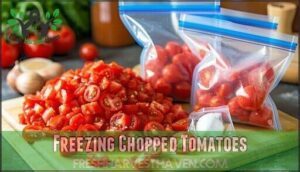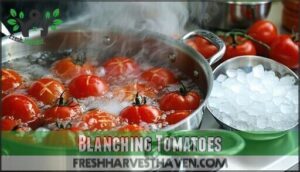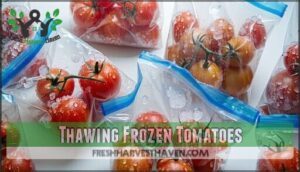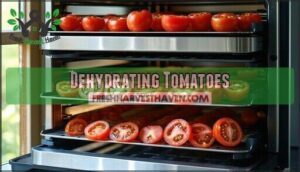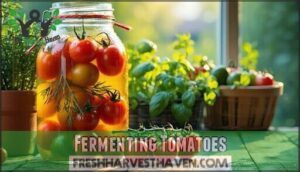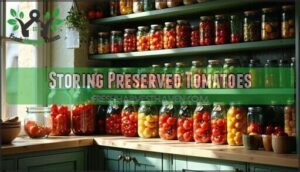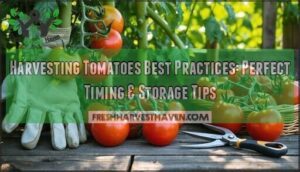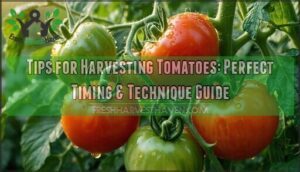This site is supported by our readers. We may earn a commission, at no cost to you, if you purchase through links.
 You’ve got five solid options for preserving tomatoes from garden harvests that’ll keep that summer flavor locked in tight.
You’ve got five solid options for preserving tomatoes from garden harvests that’ll keep that summer flavor locked in tight.
Freezing works best for sauces and soups—just wash, core, and toss whole tomatoes into freezer bags.
Canning gives you shelf-stable jars that last years, but you’ll need proper sterilization and added acidity for safety.
Dehydrating creates concentrated flavor bombs perfect for snacking or reconstituting later.
Making sauces lets you cook down your bounty into versatile bases for countless meals.
Fermenting adds probiotics and tangy complexity that transforms ordinary tomatoes into something special.
Each method has its sweet spot depending on your goals.
Table Of Contents
- Key Takeaways
- Freezing Tomatoes
- Canning Tomatoes
- Dehydrating Tomatoes
- Making Tomato Sauces
- Fermenting Tomatoes
- Storing Preserved Tomatoes
- Frequently Asked Questions (FAQs)
- What is the best way to store tomatoes?
- How to preserve summer tomatoes at the end of the season?
- How can I extend my tomato harvest?
- How do you preserve cherry tomatoes?
- What is the best way to preserve homegrown tomatoes?
- Can you just peel tomatoes and freeze them?
- What is the best way to store tomatoes from the garden?
- Can I freeze fresh tomatoes from the garden?
- What is the best way to preserve fresh tomatoes?
- What can I do with an abundance of tomatoes from my garden?
- Conclusion
Key Takeaways
- You can freeze whole tomatoes without any prep work – just wash, dry, and toss them straight into freezer bags, where they’ll keep their flavor for six months, and the skins will slip off easily after thawing.
- Canning creates shelf-stable tomatoes that last 12-18 months – you’ll need to add bottled lemon juice for safety and follow proper sterilization techniques, but this method gives you the longest storage time.
- Dehydrating concentrates tomato flavor into versatile ingredients – slice them uniformly and dry at 135-140°F for 6-12 hours to create flavor-packed pieces that work perfectly in soups, sauces, and as snacks.
- Each preservation method serves different cooking needs – frozen tomatoes work best in cooked dishes, canned tomatoes provide convenience for sauces, dehydrated tomatoes add intense flavor, and fermented varieties offer probiotic benefits.
Freezing Tomatoes
Freezing tomatoes is the quickest and easiest way to preserve your garden harvest, requiring no special equipment or complex preparation steps.
Turn your garden bounty into year-round flavor with zero fuss and maximum taste.
You can freeze whole tomatoes directly in zip-top bags, and the freezing process actually makes peeling them easier when you’re ready to use them in soups, sauces, and stews, which is a key benefit of preserving your garden harvest through this method, allowing for easy use in various dishes with minimal preparation.
Freezing Whole Tomatoes
Why struggle with tomato freezing methods when whole tomatoes make it simple? Wash and dry your ripe tomatoes thoroughly, then toss them straight into freezer bags.
Peeling Frozen tomatoes becomes effortless—skins slip right off after thawing. While Texture Changes occur, Flavor Retention stays strong for six months.
Best Varieties include beefsteaks and heirlooms. Avoid Freezing Green tomatoes since they lack developed flavor.
Remove excess air from bags to prevent freezer burn and maintain quality.
Freezing Halved Tomatoes
Halving tomatoes before freezing offers smart Halving Benefits that maximize your freezer real estate. This tomato preservation method works beautifully with meaty varieties like Roma or San Marzano.
Here’s your game plan:
- Slice clean tomatoes horizontally through the middle
- Remove seeds and gel (optional space-saver)
- Place cut-side down on parchment-lined trays
- Flash freeze for 2-3 hours until solid
- Transfer to labeled freezer bags, removing excess air
Texture Changes make these perfect for cooked dishes where Recipe Adaptations shine.
Freezing Chopped Tomatoes
Chopping tomatoes before freezing tomatoes gives you perfect freezing portions for specific recipes.
Cut your garden harvest into chunks that match your cooking needs – diced for soups, larger pieces for sauces.
Pat pieces dry to minimize texture changes, then pack in freezer bags.
Remove air completely to preserve tomato flavor and prevent freezer burn.
These prepped portions maintain excellent recipe suitability for six months of storage duration.
Blanching Tomatoes
Before freezing your garden tomatoes, blanching transforms tough-skinned fruits into preservation-ready gems. This quick heat treatment delivers blanching benefits that make peeling efficiency effortless while maintaining flavor retention and ideal texture impact for your frozen harvest.
Master blanching tomatoes with this foolproof method:
- Score an X on each tomato’s bottom with a sharp knife
- Boil water in your largest pot until rolling bubbles appear
- Submerge tomatoes for 30-60 seconds until skins start loosening
- Transfer immediately to ice bath using slotted spoon
- Peel away loosened skins with gentle finger pressure
Blanching alternatives include brief oven roasting, though traditional tomato preservation through tomato freezing works best with this classic technique.
Thawing Frozen Tomatoes
Your frozen tomatoes need the right thawing methods to maintain peak flavor impact.
Choose counter thawing (2-3 hours) for small batches, refrigerator thawing (6-8 hours) for meal prep, or warm water method (30 minutes) for quick fixes.
Texture changes are normal – expect softer tomatoes perfect for cooked dishes.
For thawing safety, keep tomatoes in sealed bags to prevent contamination.
Tomato thawing techniques vary by use: add frozen tomatoes directly to soups and sauces, or thaw completely for recipes requiring drained tomatoes.
These tomato freezing tips guarantee best uses every time.
Canning Tomatoes
You’ll need tomatoes, sterilized jars, and a large pot to create shelf-stable canned tomatoes that last up to a year.
This traditional method requires adding acid for safety and following proper canning techniques, but it gives you the longest storage time of all preservation methods, allowing for canned tomatoes to be stored for a long duration.
Canning Whole Tomatoes
While freezing works well for everyday cooking, canning whole tomatoes creates shelf-stable jars that last up to a year.
You’ll need 21 pounds of tomatoes for 7 quarts.
Jar sterilization starts in a 275°F oven for 10 minutes.
Acidity levels require two tablespoons of bottled lemon juice per quart for safety.
Headspace importance means leaving ½-inch space at the top.
Proper sealing techniques guarantee shelf stability.
The canning process transforms fresh whole tomatoes into pantry gold.
Canning Halved Tomatoes
Canning halved tomatoes cuts your prep work in half while doubling the surface area for better flavor absorption.
This method works perfectly for Roma and San Marzano varieties that hold their shape during the canning process.
Here’s your step-by-step approach for preserving tomatoes:
- Blanch halved tomatoes for 30-60 seconds until skins loosen naturally
- Add bottled lemon juice to maintain proper acidity levels for safe tomato canning
- Pack into appropriate jar size leaving correct headspace rules of 1/2-inch
- Follow recommended processing time to prevent sealing issues during storage
Canning Chopped Tomatoes
Your garden’s bounty deserves proper preservation, and canning chopped tomatoes delivers convenience with every jar. First, blanch whole tomatoes in boiling water for 60 seconds, then slip off skins easily. Dice them into uniform pieces for consistent cooking.
| Step | Details |
|---|---|
| Acidity levels | Add 1 tablespoon lemon juice per pint |
| Headspace importance | Leave ½ inch space at jar top |
| Storage duration | Properly canned tomatoes last 12-18 months |
Pre-chopped tomatoes streamline your canning process and create versatile canning recipes for future meals.
Sterilizing Jars
Proper jar sterilization forms the foundation of safe canning tomatoes. You’ll wash jars and lids with hot soapy water first.
Boiling time requires 10 minutes for sterilization methods under 1,000 feet elevation. The dishwasher method works too – run a full cycle without detergent.
Microwave sterilization isn’t recommended for canning. Consider various jar sterilizers for efficient processing.
Keep sterilized jars warm until filling to prevent temperature shock. This critical step guarantees your preserving tomatoes efforts succeed without contamination risks.
Adding Acidity
Once your sterilized jars are ready, acidification methods become your safety net. Modern tomatoes hover near the danger zone for safe pH levels, so you’ll need to add natural acids before packing.
Here’s your acidification game plan:
- Add 2 tablespoons bottled lemon juice per quart jar
- Use ½ teaspoon citric acid as an alternative option
- Cut amounts in half for pint-sized containers
- Balance tartness with a pinch of sugar
Dehydrating Tomatoes
Dehydrating transforms your fresh tomatoes into concentrated, flavor-packed pieces that can last over a year when stored properly.
You’ll remove moisture from the tomatoes using a food dehydrator, oven, or sun-drying method, creating versatile ingredients perfect for soups, sauces, and snacks.
Using Food Dehydrators
Food dehydrators turn your tomato harvest into concentrated flavor powerhouses with precise temperature control.
Turn your garden’s bounty into flavor-packed gems that’ll make every dish sing with concentrated tomato magic.
Set your machine between 135-140°F for ideal results, though different dehydrator types may require slight adjustments.
Most tomato varieties work well, but paste tomatoes like Roma dry faster than juicy beefsteaks.
Consider exploring options for tomato dehydrator models to find the best fit for your needs.
Here are five key steps for dehydrating tomatoes successfully:
- Slice tomatoes uniformly (¼ to ½ inch thick) for even drying
- Consider pre-treatment options like light salt sprinkling to draw out moisture
- Arrange slices on trays without overlapping for proper air circulation
- Monitor progress every 2-3 hours during the 6-12 hour drying process
- Test doneness by checking for leathery texture that’s still pliable
Troubleshooting tips include rotating trays periodically and removing smaller pieces first.
Your finished tomatoes can become tomato powder when ground, creating versatile preserving methods that’ll last months in proper storage, using precise temperature control for ideal results, and following these steps for dehydrating tomatoes to achieve the perfect concentrated flavor with proper air circulation and even drying.
Oven Drying Tomatoes
Why settle for store-bought when you can create your own sundried tomatoes at home?
Your regular oven transforms fresh tomatoes into concentrated flavor bombs through simple dehydrating tomatoes techniques. Set your oven temperature to 150°F and arrange sliced tomatoes on parchment-lined baking sheets. Drying time varies by variety, but patience pays off with incredible results.
| Tomato Varieties | Drying Time | Slice Thickness | Seasoning Options | Storage Methods |
|---|---|---|---|---|
| Roma/Plum | 6-8 hours | 1/4 inch | Salt, herbs | Airtight containers |
| Cherry | 4-6 hours | Halved | Garlic powder | Vacuum sealed bags |
| Beefsteak | 8-10 hours | 1/2 inch | Black pepper | Freezer bags |
| San Marzano | 7-9 hours | 1/3 inch | Italian seasoning | Glass jars |
| Grape | 3-5 hours | Halved | Sea salt | Oil-packed jars |
Sun Drying Tomatoes
Successfully sun drying tomatoes requires consistent 90°F temperatures and humidity below 60% for 4-10 days.
Cut your best tomato variety in half, sprinkle with sea salt, and place on raised screens for airflow. Consider using specialized drying racks to optimize this process.
Cover with cloth to prevent insects while allowing flavor intensification. Traditional methods like ceramic rooftop drying concentrate sweetness as tomatoes lose 82-90% of their weight.
Monitor every few hours, preventing mold through proper ventilation.
Storing Dried Tomatoes
Your dehydrated tomatoes deserve proper storage to maintain their concentrated flavor.
Pack completely dried tomatoes in airtight containers or use vacuum sealing for maximum freshness. Pantry conditions work for six months, while fridge storage extends shelf life to eighteen months.
Consider these storage essentials:
- Keep containers in cool, dark locations away from heat
- Check periodically for moisture that could cause spoilage
- Label with dates for rotation
Reconstituting Dried Tomatoes
Once you’ve mastered storing your dried tomatoes, you’ll want to bring them back to their juicy glory.
Reconstituting dried tomatoes transforms shriveled pieces into plump, flavorful gems. Soak them in warm water, broth, or wine for 20-60 minutes depending on thickness.
Rehydration liquids enhance flavor enhancement while restoring texture. Save that soaking liquid—it’s liquid gold for cooking applications like soups and sauces.
Making Tomato Sauces
You can transform your fresh tomatoes into versatile sauces that’ll keep for months when stored properly.
Making tomato sauce concentrates the flavors while giving you a base ingredient that works in countless recipes, from pasta dishes to pizza toppings, using your freshly made tomato sauce.
Simple Tomato Sauce
Simple tomato sauce transforms your garden bounty into liquid gold that’s perfect for preserving tomatoes. You’ll blend fresh garden tomatoes with garlic, then simmer until thick. This basic tomato sauce recipe works beautifully for canning tomatoes or freezing batches.
Master these Sauce Texture Secrets for perfect consistency:
- Cook uncovered to concentrate flavors naturally
- Blend smooth or leave chunky based on preference
- Add salt gradually while tasting for balance
- Simmer low and slow for richest Sauce Flavor Boosters
- Control Sauce Acidity Control with lemon juice additions
Roasted Tomato Sauce
Roasted tomato sauce transforms ordinary garden tomatoes into liquid gold. Roasting techniques caramelize natural sugars, creating depth that regular sauces can’t match.
You’ll control sweetness balance and acidity levels by adjusting oven temperature and time. Herb infusions like basil or oregano elevate flavor profiles.
This preserving tomatoes method works with any variety—cherry tomatoes roast faster than beefsteak. Blend roasted tomatoes smooth or chunky.
These tomato recipes freeze beautifully for year-round sauce variations.
Homemade Ketchup
Homemade ketchup transforms your fresh tomatoes into a versatile condiment that beats store-bought versions.
You’ll control sweeteners compared to commercial brands, experimenting with honey, maple syrup, or brown sugar.
Spice combinations like smoked paprika, garlic powder, or cayenne create unique ketchup variations.
Different cooking methods affect texture—slow simmering develops deeper flavors while quick reduction maintains brightness.
Storage options include freezing portions or water-bath canning for shelf stability, making this tomato preservation method perfect for homemade condiments.
Tomato Paste
Tomato paste packs incredible homemade flavor into your kitchen arsenal.
You’ll create this concentrated powerhouse by slowly cooking pureed tomatoes until thick and rich.
Paste varieties depend on your tomato choice—San Marzanos deliver sweetness while Roma tomatoes provide body.
Canning paste preserves it for months, though freezing paste works equally well.
Store small portions in ice cube trays for convenient culinary uses in soups, stews, and tomato recipes.
Canning Sauces
After perfecting your tomato paste, canning sauces becomes your next preservation adventure. You’ll transform your garden bounty into shelf-stable treasures that last months.
Sauce acidity requires careful attention for canning safety. Add lemon juice to each jar, maintaining proper pH levels that prevent dangerous bacteria growth. Your homemade tomato sauce needs this acidification step – it’s not optional.
Consider these factors for successful tomato canning:
- Sauce thickness: Use 35 pounds of tomatoes for thin sauce, 46 pounds for thick varieties
- Flavor variations: Add herbs and spices before processing for enhanced taste
- Jar sealing: Follow headspace guidelines and pack firmly to guarantee proper seals
Store your canned tomato recipes in cool, dry places for maximum freshness.
Fermenting Tomatoes
You’ll turn your fresh tomatoes into tangy, probiotic-rich foods through fermentation, a process that uses beneficial bacteria to preserve and enhance flavor.
This method creates unique products like fermented salsa and cherry tomatoes that can last for months while providing health benefits through natural probiotics.
Lacto Fermented Salsa
Beyond making basic tomato sauces, you can explore lacto-fermented salsa for a probiotic-packed twist on preserving tomatoes.
This fermentation process transforms your garden harvest into a tangy, gut-friendly condiment that’s loaded with probiotic benefits.
Start with fresh salsa ingredients: tomatoes, onions, peppers, and garlic.
Chop everything, add sea salt, and pack into a jar.
The salt creates the perfect environment for beneficial bacteria to work their magic.
Recipe variations are endless—add cilantro, jalapeños, or cumin to customize flavor profiles.
The fermentation takes 3-7 days at room temperature.
You’ll know it’s ready when bubbles form and the taste develops that signature tangy kick that makes lacto-fermented salsa special for gut health.
Fermented Cherry Tomatoes
While lactofermented salsa transforms larger tomatoes, cherry tomatoes shine as standalone fermented treats.
These bite-sized "cherry bombs" develop intense flavor through controlled fermentation, creating probiotic foods that pack serious taste.
Your cherry tomato fermentation guide:
- Brine Recipes: Mix 2 tablespoons sea salt per cup of filtered water for ideal fermentation
- Fermentation Time: Let them bubble for 5-7 days at room temperature before refrigerating
- Spicing Options: Add garlic, peppercorns, or herbs to customize your flavor profile
- Texture Changes: Expect softer skins while maintaining that satisfying pop when bitten
Serving Ideas: Toss these tangy gems into salads, grain bowls, or enjoy straight from the jar as a healthy snack.
Green Tomato Olives
You’ll transform garden tomatoes into something that tastes surprisingly like real olives through olive brining techniques.
This pickling method works best with firm green tomato varieties like Green Zebra or Cherokee Purple’s unripe fruits.
The fermentation process creates an authentic olive flavor profile and firm olive texture that’ll fool your taste buds.
Try different recipe variations by adding garlic, herbs, or spices to your brine.
These pickled green tomatoes make excellent appetizers and conversation starters at dinner parties.
Fermented Ketchup
Fermented ketchup transforms your preserving tomatoes game with lactofermentation. This homemade ketchup develops complex flavor profiles through natural fermentation process, creating beneficial probiotics.
You’ll love experimenting with recipe variations – add garlic, herbs, or spices for your signature blend. The fermenting tomatoes method takes days, not hours, but patience pays off.
Storage methods require refrigeration after fermentation completes. This tangy condiment offers health implications beyond regular ketchup, making fermentation an exciting preservation technique worth mastering.
Health Benefits
Your fermented ketchup packs serious health benefits that go way beyond regular tomato preservation.
Fermenting tomatoes boosts their antioxidant properties and lycopene benefits, giving you more heart-protective compounds than fresh tomatoes.
The fermentation process creates beneficial probiotics that support digestive health and strengthen your immune system.
You’re getting enhanced vitamin content plus gut-friendly bacteria that help your body absorb nutrients better.
This preserving tomatoes method delivers probiotic benefits while maintaining the natural heart health advantages that make tomatoes such nutritional superstars.
Storing Preserved Tomatoes
Once you’ve preserved your tomatoes using any of these methods, proper storage becomes essential for maintaining quality and extending shelf life.
You’ll need to understand specific storage requirements for each preservation method, from freezer temperatures to pantry conditions, to keep your tomatoes fresh and safe for months.
Freezer Storage
After preserving your tomatoes through fermentation, proper freezer storage keeps your harvest fresh for months.
Your frozen tomatoes need the right environment to maintain their quality and prevent freezer burn.
Use freezer-grade bags and remove excess air before sealing. Label each bag with contents and date, then store flat to save space.
Keep your freezer at 0°F or below for ideal storage conditions.
Here’s what proper freezer storage gives you:
- Peace of mind knowing your harvest won’t go to waste
- Year-round access to garden-fresh tomato flavor
- Space efficiency with flat storage maximizing freezer real estate
- Quality preservation that maintains texture and prevents freezer burn
Refrigerator Storage
Your refrigerator storage strategy makes all the difference for fresh tomatoes from your garden harvest.
Store ripe tomatoes at 50-55°F with 75% humidity for ideal tomato preservation.
Different tomato varieties require proper handling – keep stems up and avoid overcrowding.
These storage tips slow tomato ripening while maintaining flavor.
Master tomato storage techniques, and you’ll enjoy peak freshness longer.
Shelf Life
Knowing your tomato shelf life helps you plan meals and avoid waste.
Fresh tomatoes last about a week at room temperature, while refrigeration adds another week to their food storage timeline.
Canning duration extends this to 12-18 months for high-acid varieties and up to five years for low-acid types.
Dehydration storage keeps tomatoes good for one year when properly dried.
Fermentation length produces tomatoes lasting 6-12 months refrigerated, substantially impacting your recipe impact and meal planning success.
Preventing Freezer Burn
Your tomatoes won’t last long with freezer burn sneaking in. Air removal is your first defense against this flavor thief.
Use quality packaging materials like freezer-grade bags, then squeeze out every air bubble before sealing. Temperature control matters too—keep your freezer at 0°F or below for ideal freezer storage.
Blanching effects help preserve tomato texture and tomato flavor retention when done before freezing tomatoes. Think of proper packaging as armor protecting your harvest.
Storage duration stays maximum when air can’t reach your tomatoes. These freezer burn prevention steps keep your preserved bounty tasting garden-fresh all winter long.
Using Preserved Tomatoes
Your preserved tomatoes become culinary game-changers with smart recipe adaptations.
Frozen tomatoes work perfectly in tomato-based dishes like chili and pasta sauce, though texture differences make them unsuitable for fresh applications.
Dehydrated varieties pack intense flavor intensities that enhance soups and stews.
Nutritional changes remain minimal across preservation methods.
These homemade tomato treasures offer significant cost savings while expanding your culinary applications.
Smart flavor enhancement happens when you match preservation method to recipe needs.
Frequently Asked Questions (FAQs)
What is the best way to store tomatoes?
Store fresh tomatoes at room temperature until ripe, then refrigerate for up to a week. For long-term preservation, you can freeze whole tomatoes, can them, or dehydrate for concentrated flavor.
How to preserve summer tomatoes at the end of the season?
Freeze whole tomatoes in zip-top bags for six months of flavor.
Can them in sterilized jars for year-long storage.
Dehydrate slices at 112°F overnight for concentrated taste that’ll last eighteen months properly stored.
How can I extend my tomato harvest?
Pick green tomatoes before frost hits, then ripen them indoors on windowsills or in paper bags. You’ll extend your harvest by weeks, enjoying fresh tomatoes well into fall.
How do you preserve cherry tomatoes?
Like Victorian homesteaders stockpiling provisions, you’ll freeze cherry tomatoes whole in zip-top bags after washing and drying them.
They’ll keep their vibrant flavor for six months, perfect for soups and sauces later.
What is the best way to preserve homegrown tomatoes?
You’ll get the best results by freezing whole tomatoes in zip-top bags for six months of fresh flavor, or canning them for year-long storage, depending on your space and time.
Can you just peel tomatoes and freeze them?
Here’s the surprising truth: you don’t need to peel tomatoes before freezing them.
Simply wash, dry, and toss whole tomatoes into freezer bags.
The skins will slip off effortlessly after thawing, making prep work a breeze.
What is the best way to store tomatoes from the garden?
Ripen tomatoes on counters away from sunlight, then refrigerate once fully red. You’ll preserve flavor and extend shelf life by storing unripe ones at room temperature first.
Can I freeze fresh tomatoes from the garden?
Fresh garden tomatoes burst with summer flavor, yet winter’s scarcity looms ahead.
You can absolutely freeze whole tomatoes straight from your garden—no peeling required!
Simply wash, dry, and store in freezer bags for six months of preserved goodness.
What is the best way to preserve fresh tomatoes?
Freezing offers the quickest preservation method – just wash, dry, and store whole tomatoes in freezer bags.
For longer storage, try canning or dehydrating. Each method preserves flavor differently for various recipes.
What can I do with an abundance of tomatoes from my garden?
You can freeze whole tomatoes in zip-top bags, can them as sauce or paste, or dehydrate into sun-dried tomatoes. Each method preserves your harvest for months while maintaining flavor.
Conclusion
Mastering preserving tomatoes from garden harvests will absolutely revolutionize your year-round cooking game.
You’ve now got five proven methods that’ll transform those peak-season beauties into shelf-stable treasures.
Whether you’re freezing for convenience, canning for longevity, dehydrating for intensity, sauce-making for versatility, or fermenting for health benefits, each technique serves a specific purpose.
Pick the method that matches your needs, follow the safety guidelines, and you’ll enjoy garden-fresh tomato flavor throughout the entire year.

